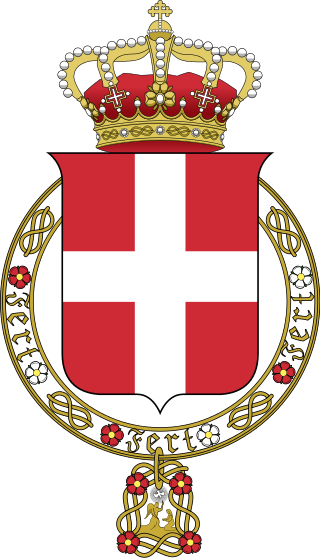
The House of Savoy is an Italian royal house that was established in 1003 in the historical Savoy region. Through gradual expansions the family grew in power, first ruling a small Alpine county northwest of Italy and later gaining absolute rule of the Kingdom of Sicily. During the years 1713 to 1720, they were handed the island of Sardinia and would exercise direct rule from then onward.
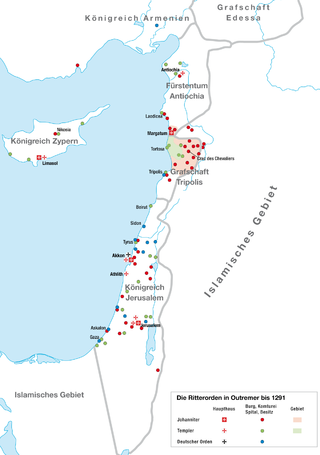
A military order is a Christian religious society of knights. The original military orders were the Knights Templar, the Knights Hospitaller, the Order of the Holy Sepulchre, the Order of Saint James, the Order of Calatrava, and the Teutonic Knights. They arose in the Middle Ages in association with the Crusades, in the Holy Land, the Baltics, and the Iberian peninsula; their members being dedicated to the protection of pilgrims and Christians, as well as the defence of the Crusader states. They are the predecessors of chivalric orders.

The Equestrian Order of the Holy Sepulchre of Jerusalem, also called the Order of the Holy Sepulchre or Knights of the Holy Sepulchre, is a Catholic order of knighthood under the protection of the Holy See. The Pope is the sovereign of the order. The order creates canons as well as knights, with the primary mission to "support the Christian presence in the Holy Land". It is an internationally recognised order of chivalry. The order today is estimated to have some 30,000 knights and dames in 60 lieutenancies around the world. The Cardinal Grand Master has been Fernando Filoni since 2019, and the Latin Patriarch of Jerusalem is ex officio the Order's Grand Prior. Its headquarters are situated at the Palazzo Della Rovere and its official church in Sant'Onofrio al Gianicolo, both in Rome, close to Vatican City. In 1994, Pope John Paul II declared the Virgin Mary as the order's patron saint under the title "Blessed Virgin Mary, Queen of Palestine".

Mendicant orders are, primarily, certain Catholic religious orders that have vowed for their male members a lifestyle of poverty, traveling, and living in urban areas for purposes of preaching, evangelization, and ministry, especially to the poor. At their foundation these orders rejected the previously established monastic model, which prescribed living in one stable, isolated community where members worked at a trade and owned property in common, including land, buildings and other wealth. By contrast, the mendicants avoided owning property at all, did not work at a trade, and embraced a poor, often itinerant lifestyle. They depended for their survival on the goodwill of the people to whom they preached. The members of these orders are not called monks but friars.
There were two military orders known as the Order of Our Lady of Bethlehem.

Bethlehemites, or Bethlemites, is the name of five Catholic religious orders. Two of them were restored to existence in the 20th century. The other three are extinct.
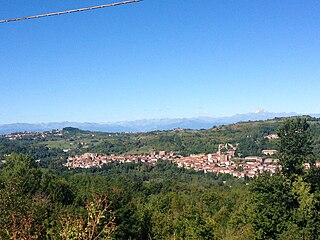
San Michele Mondovì is a comune (municipality) in the Province of Cuneo in the Italian region Piedmont, located about 80 kilometres (50 mi) south of Turin and about 30 kilometres (19 mi) east of Cuneo. As of 31 December 2004, it had a population of 2,064 and an area of 18.2 square kilometres (7.0 sq mi).

Calosso is a rural comune (municipality) in the Province of Asti in the Italian region Piedmont, located about 60 kilometres (37 mi) southeast of Turin and about 20 kilometres (12 mi) south of Asti in the hilly area between the Tanaro and Belbo and on the borders between Monferrato and Langa. As of 31 January 2024, it had a population of 1,112 and an area of 15.7 square kilometres (6.1 sq mi).
The Roman Catholic Diocese of Bethléem à Clamecy was a crusader bishopric in residential exile with see at Clamecy, Nièvre in Burgundy, eastern France, made exempt.

Spirano is a comune (municipality) in the Province of Bergamo in the Italian region of Lombardy, located about 40 kilometres (25 mi) northeast of Milan and about 13 kilometres (8 mi) south of Bergamo.

Adelaide of Turin was the countess of part of the March of Ivrea and the marchioness of Turin in Northwestern Italy from 1034 to her death. She was the last of the Arduinici. She is sometimes compared to her second cousin and close contemporary, Matilda of Tuscany.
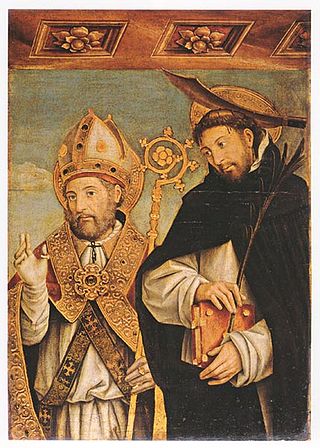
Evasius is believed to have been a missionary and bishop of Asti, in north-west Italy. He was forced to flee to the great Padan forest known as the Selva Cornea, where he and numerous followers were beheaded by pagan, or alternatively by Arian enemies, in the area of what is now Casale Monferrato. He is venerated as a saint of the Roman Catholic Church and is the patron of a number of towns in Piedmont and Lombardy. His cult is liveliest at Casale, where his remains are conserved in the cathedral dedicated to him.
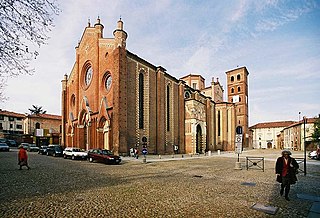
The Diocese of Asti is a Latin diocese of the Catholic Church in Piedmont, northern Italy, centered in the city of Asti. It has been a suffragan of the Archdiocese of Turin since 1515. Previous to that, it was a suffragan of the Archdiocese of Milan.

The Turco, Turchi, Turci or sometimes Turco dei De Castello family's rise to prominence originated in 12th-century Asti, Italy, and later the surrounding comunes of Frinco, Mombercelli, Montemagno, Tonco, Viale, and in part Barbaresco, Neive, Revigliasco d'Asti and Savigliano. They are considered one of the "Casane Astigiane", the major familial banking "houses" that powered the economy of medioeval Asti.

The Palio di Asti is a traditional Italian festival of medieval origin that culminates with a bareback horse race.
The See or Diocese of Bethlehem was a diocese in the Roman Catholic Church during the Crusades and is now a titular see. It was associated with the Roman Catholic Diocese of Nevers.

The Bethlehemite Brothers are a religious institute founded in Guatemala in 1653 and restored in 1984.

Saint Ambrose is a small church which is an annex to the farmhouse that takes its name from it, in Brugherio, Italy.

Santissima Trinità is a Catholic church in Alcamo, in the province of Trapani.

The Ceva Grimaldi are an Italian noble family established in Southern Italy since the 16th century but whose origins are in Piedmont and Liguria and date back to the 10th century. The main titles associated with this branch of the Ceva family are Marchese di Pietracatella and Duca di Telese.

















